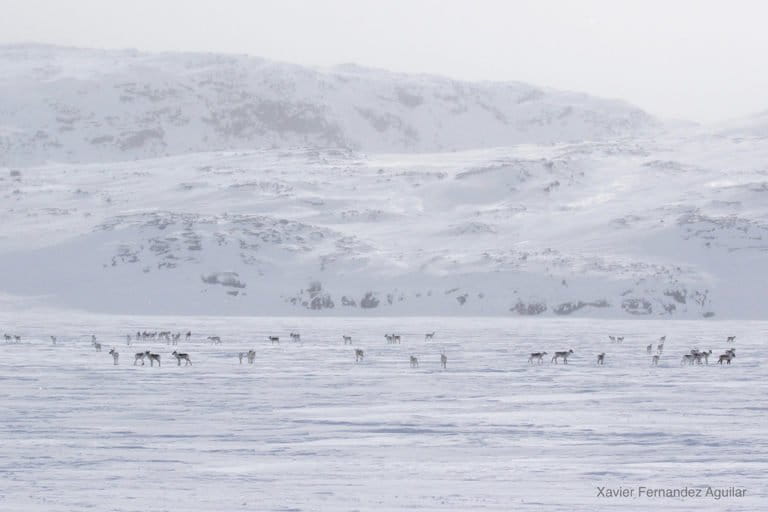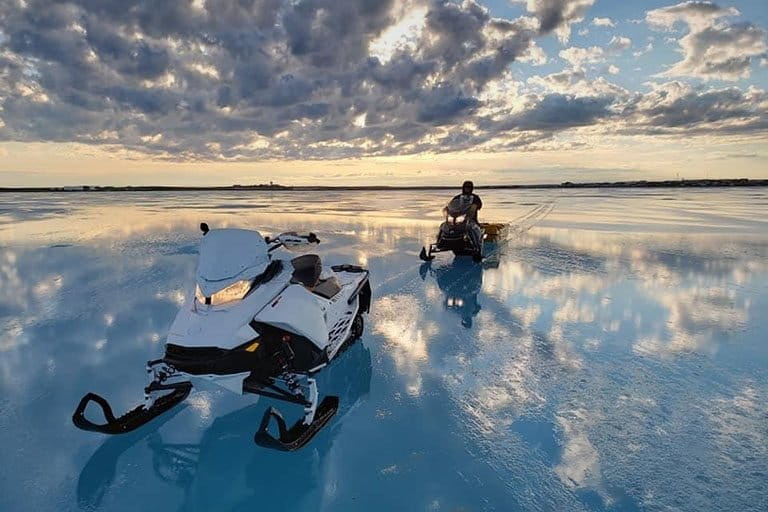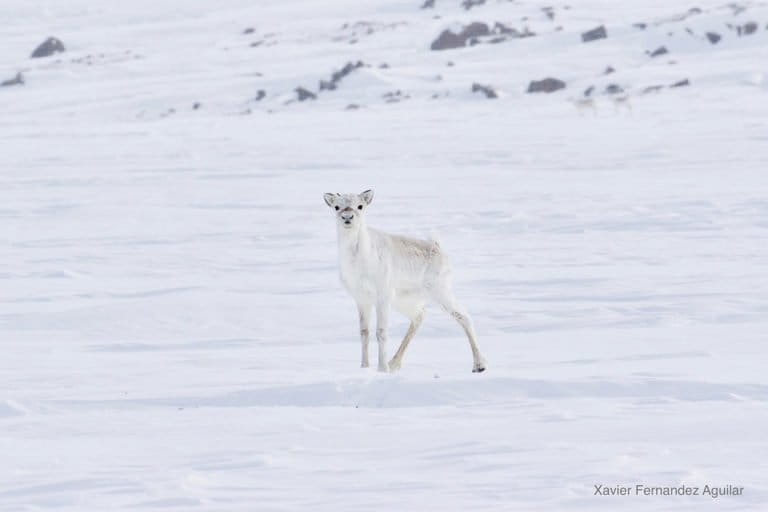Commentary by Martin Robards and Beverly Maksagak on 3 November 2020
A little-considered impact of warming temperatures in the Arctic is the increased activity of ice breakers.
Martin Robards, Regional Director for the Arctic Beringia Program at the Wildlife Conservation Society, and Beverly Maksagak, Manager of the Ekaluktutiak Hunters and Trappers Organization, write that ice breakers potentially pose a threat to traditional Inuit ways of life.
Robards and Maksagak write about the Proactive Vessel Management (PVM) initiative, which last year brought together communities, industry, and vessel operators find solutions to issues of concern on Arctic waterways.
This post is a commentary: the views expressed are those of the author, not necessarily Mongabay.
The solitude of the north is changing. George Angohiatok noticed this quite graphically a decade ago when, after returning to Iqaluktuuttiaq (or Cambridge Bay, as it was renamed by settlers), he observed an ice breaker moving through the same frozen waterways he had travelled by snow machine the day before.
If the vessel had smashed that open lead through the frozen veneer of ice a day earlier, he would have been cut off for at least a few weeks until the ice refroze. George wonders whether, even with his headlights, he would have detected the steam that signals the transition from ice to water in winter through his goggles.
The growing presence of ice breakers worries George. His Inuit ancestors moved east across the Arctic coast of North America thousands of years ago. Since that time, the waterways have been their highways, both in summer and winter. Traveling between camps and villages, the Inuit have followed the wildlife at the heart of their food security.
The caribou herds of the far northern islands—the Dolphin and Union herd and the Peary herds—also stride out onto the sea ice during their migrations between summer and wintering areas. The herds contribute heavily to the Inuit’s essential needs—providing both a source of “country food” and clothing with fur that is warm beyond compare. In the past elders have used the leg bones for carving and to build shelters.
A little-considered impact of warming temperatures in the Arctic is the increased activity of ice breakers.
Martin Robards, Regional Director for the Arctic Beringia Program at the Wildlife Conservation Society, and Beverly Maksagak, Manager of the Ekaluktutiak Hunters and Trappers Organization, write that ice breakers potentially pose a threat to traditional Inuit ways of life.
Robards and Maksagak write about the Proactive Vessel Management (PVM) initiative, which last year brought together communities, industry, and vessel operators find solutions to issues of concern on Arctic waterways.
This post is a commentary: the views expressed are those of the author, not necessarily Mongabay.
The solitude of the north is changing. George Angohiatok noticed this quite graphically a decade ago when, after returning to Iqaluktuuttiaq (or Cambridge Bay, as it was renamed by settlers), he observed an ice breaker moving through the same frozen waterways he had travelled by snow machine the day before.
If the vessel had smashed that open lead through the frozen veneer of ice a day earlier, he would have been cut off for at least a few weeks until the ice refroze. George wonders whether, even with his headlights, he would have detected the steam that signals the transition from ice to water in winter through his goggles.
The growing presence of ice breakers worries George. His Inuit ancestors moved east across the Arctic coast of North America thousands of years ago. Since that time, the waterways have been their highways, both in summer and winter. Traveling between camps and villages, the Inuit have followed the wildlife at the heart of their food security.
The caribou herds of the far northern islands—the Dolphin and Union herd and the Peary herds—also stride out onto the sea ice during their migrations between summer and wintering areas. The herds contribute heavily to the Inuit’s essential needs—providing both a source of “country food” and clothing with fur that is warm beyond compare. In the past elders have used the leg bones for carving and to build shelters.

The Dolphin and Union caribou herd. Photo © Xavier Fernandez Aguilar.
Use of the sea and ice by people has been relatively predictable over past millennia. Harsh winters and only a few months of open water warded off all but the most determined visitors. Even a casual read of Pierre Berton’s The Arctic Grail provides a clear picture of just how challenging these areas are. Unprepared visitors throughout history have perished.
But things change. The powerful Finish Polar Class icebreakers MSV Fennica and MSV Nordica passed this way in October of 2015, returning home from supporting oil exploration off Alaska in the Chukchi Sea; both vessels capable of ramming their way through ice a meter thick unassisted.
In 2017, the ice breaker MV Xue Long (Snow Dragon) passed by in August. While not a winter transit, it was a clear demonstration of the increasing interest and capacity of the Chinese to explore Arctic waters. And Russia just launched the first in a new generation of what are the largest and most powerful nuclear-powered icebreakers, Arktika, capable of traveling through ice up to 3 meters thick!
Use of the sea and ice by people has been relatively predictable over past millennia. Harsh winters and only a few months of open water warded off all but the most determined visitors. Even a casual read of Pierre Berton’s The Arctic Grail provides a clear picture of just how challenging these areas are. Unprepared visitors throughout history have perished.
But things change. The powerful Finish Polar Class icebreakers MSV Fennica and MSV Nordica passed this way in October of 2015, returning home from supporting oil exploration off Alaska in the Chukchi Sea; both vessels capable of ramming their way through ice a meter thick unassisted.
In 2017, the ice breaker MV Xue Long (Snow Dragon) passed by in August. While not a winter transit, it was a clear demonstration of the increasing interest and capacity of the Chinese to explore Arctic waters. And Russia just launched the first in a new generation of what are the largest and most powerful nuclear-powered icebreakers, Arktika, capable of traveling through ice up to 3 meters thick!
Drift ice camp in the middle of the Arctic Ocean as seen from the deck of icebreaker Xue Long. Photo @copy; Timo Palo.
The convergence of technology, loss of one third the summer sea ice over the past two decades, and both economic and political interest have led the Arctic’s frozen backwaters to be targeted as highways between the Atlantic and Pacific—but also as the most efficient way to serve a growing number of mines and oil and gas developments, Bulk Carriers—those vessels serving the mining industry for transport of ore—have alone increased their Arctic travel by 160 percent between 2013 and 2019!
The Fennica and Nordica travelled with a local observer and ice pilots guided by 30 years of experience. But as things get busier, what will become of vessels entering these frozen waters with less on-board experience of the north? Or without an understanding of Inuit and wildlife passage across the sea ice?
These are the types of questions that were addressed a year ago by the Proactive Vessel Management (PVM) initiative, part of Transport Canada’s Ocean Protection Plan. The initiative was designed to bring communities, industry, and vessel operators together to proactively find solutions to issues of concern on the waterways.
The Ekaluktutiak Hunters and Trappers Organization (HTO) conducted a workshop in October 2019 that brought together federal agencies representing shipping and wildlife, ice breaker operators, the mining industry, and local hunters.
The convergence of technology, loss of one third the summer sea ice over the past two decades, and both economic and political interest have led the Arctic’s frozen backwaters to be targeted as highways between the Atlantic and Pacific—but also as the most efficient way to serve a growing number of mines and oil and gas developments, Bulk Carriers—those vessels serving the mining industry for transport of ore—have alone increased their Arctic travel by 160 percent between 2013 and 2019!
The Fennica and Nordica travelled with a local observer and ice pilots guided by 30 years of experience. But as things get busier, what will become of vessels entering these frozen waters with less on-board experience of the north? Or without an understanding of Inuit and wildlife passage across the sea ice?
These are the types of questions that were addressed a year ago by the Proactive Vessel Management (PVM) initiative, part of Transport Canada’s Ocean Protection Plan. The initiative was designed to bring communities, industry, and vessel operators together to proactively find solutions to issues of concern on the waterways.
The Ekaluktutiak Hunters and Trappers Organization (HTO) conducted a workshop in October 2019 that brought together federal agencies representing shipping and wildlife, ice breaker operators, the mining industry, and local hunters.

Ryan Angohiatok and Ivor Maksagak venture out on the sea ice south of Cambridge Bay to measure ice thickness. Credit © Ryan Angohiatok.
Based on maps of hunter travel and research on caribou migrations, annual ice conditions, and vessel routes, workshop members mapped the times and places where threats to caribou or people could occur. They sought solutions balancing food security, traveler safety, risk to caribou, and local and national economic development needs.
Through the International Maritime Organization’s new Polar Code, operators in the Arctic must plan voyages to avoid impacts to Indigenous Peoples, but can only do so through the documentation of times, places, and mitigation measures that work.
As a result of the workshop, a Notice to Mariners will now be published each year that includes these details for vessel captains and operators. Mariners can avoid the riskiest times when people and caribou are using the frozen waterways around Cambridge Bay. They coordinate with local representatives on what to do if transit is unavoidable.
Based on maps of hunter travel and research on caribou migrations, annual ice conditions, and vessel routes, workshop members mapped the times and places where threats to caribou or people could occur. They sought solutions balancing food security, traveler safety, risk to caribou, and local and national economic development needs.
Through the International Maritime Organization’s new Polar Code, operators in the Arctic must plan voyages to avoid impacts to Indigenous Peoples, but can only do so through the documentation of times, places, and mitigation measures that work.
As a result of the workshop, a Notice to Mariners will now be published each year that includes these details for vessel captains and operators. Mariners can avoid the riskiest times when people and caribou are using the frozen waterways around Cambridge Bay. They coordinate with local representatives on what to do if transit is unavoidable.

Caribou calf. Photo © Xavier Fernandez Aguilar
For example, if ice breakers are present, informing local communities of their presence, reducing speed, and maintaining a single channel to minimize damage to the ice that can take weeks to re-form can all help avoid a catastrophic situation for caribou and people.
The Notice to Mariners, penned through the efforts of the Ekaluktutiak HTO, has provided a local voice in avoiding impacts from these new global visitors. Hopefully,
For example, if ice breakers are present, informing local communities of their presence, reducing speed, and maintaining a single channel to minimize damage to the ice that can take weeks to re-form can all help avoid a catastrophic situation for caribou and people.
The Notice to Mariners, penned through the efforts of the Ekaluktutiak HTO, has provided a local voice in avoiding impacts from these new global visitors. Hopefully,

No comments:
Post a Comment